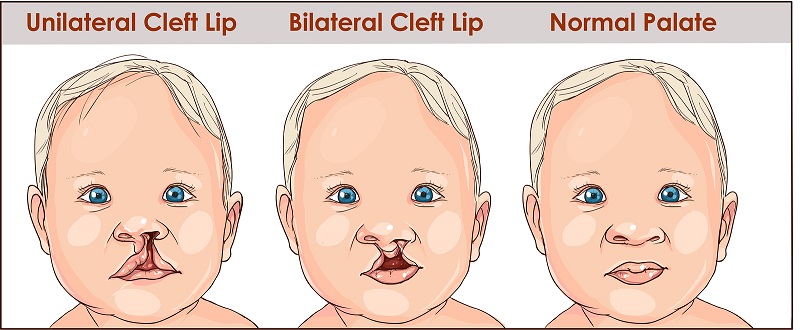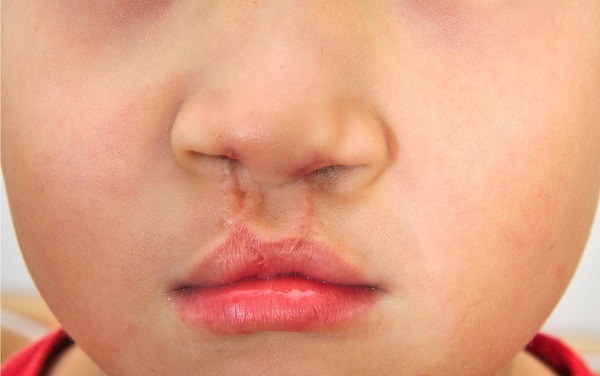Some dental problems have their origins in birth defects. We discuss here one of those defects, cleft lip and palate. These conditions often lead to complications that require the attention of many other health professionals. Below, we present the definition, causes, complications, and treatment for cleft lip and palate.
What Are Cleft Lip and Cleft Palate?
A cleft lip is a gap in the lip of a newborn. The opening results when the tissue from which the lip forms does not join completely during pregnancy. Normally, the lip forms between weeks four and seven of pregnancy, which means that cleft lip can occur early in the first trimester.
The width of the cleft lip can vary from child to child. Usually, you will notice the opening on one of the sides of the mouth. In rare cases, cleft lip forms in the center of the lip area.
Babies who have a cleft lip might also have a cleft palate. As with a cleft lip, tissue does not join completely. In a cleft palate, this failure occurs in the roof of the mouth. The opening can happen in the front and rear of the palate, or just in a portion of it. Usually, this condition can appear after six or nine weeks of pregnancy, fairly early.

How Do You Get a Cleft Palate?
Why tissue in the lip or mouth does not join completely is not known as a general rule. However, genetics, drugs, and lifestyle can, in varying degrees, place certain newborns at risk for cleft lip or palate:
- Genetics: A number of studies suggest that a family history of cleft lip or palate increases the risk that the newborn will have the condition. For example, the chances of a first degree relative of someone with cleft lip having it themselves are multiplied by 32 over a newborn whose family has not had cleft lip.
- Smoking: As with many conditions, cleft lip and cleft palate become more likely among those mothers who smoke than those who abstain.
- Nutrition: Folic acid deficiencies can contribute to cleft lip and palate. This vitamin and other nutrients promote the growth and development of the fetus. The lack of folic acid is also linked to other birth defects such as neural tube defects.
- Diabetes and obesity: Those diagnosed with diabetes prior to pregnancy and those with a body mass index at 30 or more stand a greater chance of having a child with cleft lip, cleft palate, or both.
- Drugs: If you are pregnant or planning to be so, consult with your doctor before taking medicines to treat certain conditions such as epilepsy, arthritis, and cancer. For instance, anti-seizure and anti-convulsant drugs and those containing methotrexate and Accutane have been connected to cleft lip and cleft palate.
How Is Cleft Lip and Palate Detected?
As cleft lip or palate rears itself early in pregnancy, ultrasounds typically discover these defects. Using sound waves generated by the ultrasound equipment, the provider captures an image of the fetus within the womb. The importance of prenatal visits manifests itself in the ultrasounds and other examinations that catch cleft lip or palate and other birth defects.
Even in the absence of ultrasounds, cleft lip or palate gets diagnosed through a physical examination of the nose, throat, mouth, and lip.
What Are the Complications From Cleft Lip or Cleft Palate?
The gaps in the lip or palate mean more than asethetics. If not corrected, cleft palate and cleft lip can interrupt eating, speech, and hearing, and lead to other complications.
- Feeding: The gaps that characterize cleft palate can allow food to go into the nasal areas. As a fix for newborns, consider baby bottles designed to direct milk and juices to the stomach. Children with cleft palate can use artificial palates to cover the opening.
- Hearing: Through the opening in the palate, bacteria and other agents can invade the ear and spawn an infection. The accumulation of fluid can contribute to hearing loss if the infection festers unattended.
- Speech: A cleft lip or cleft palate may result in speech impediments that may be corrected with surgery or treatment from a speech pathologist. Words from those with cleft lip or cleft palate are difficult to understand because the noises carry poorly and assume a nasal sound.
- Dental Issues: Treatment from dentists, orthodontists, or oral surgeons often follows children with cleft lip or palate. The impacts include missing or crooked teeth, cavities, malformities, and extra teeth. In a condition known as alveolar ridge defect, the upper bony gum lacks the capacity to support the teeth. From this complication can come teeth that rotate, displace, or disappear.
How Common is Cleft Lip and Palate?
The particulars of the answer depend upon the source of the data, though generally, these conditions are not rare. According to the University of Virginia School of Medicine’s website, roughly one of every 500 to 1,000 babies have cleft lip and palate.
Based on statistics, certain racial or ethnic groups are more susceptible to having cleft lip or palate (or both). As reported by the National Institutes of Health, the ratio of Asian and Native American babies with cleft lip, with or without cleft palate, stands at 1 to 500. Latino populations also have a higher risk of cleft lip, with or without cleft palate. Statistically, African Americans are the least likely to have the condition, as the ratio is one per 2,500 newborns.
Cleft Lip and Palate Treatment
As a corrective measure, surgery constitutes the primary cleft lip and palate treatment. The procedures usually happen shortly after birth. Generally, those with cleft lip should have surgery before turning one year old. The procedure to fix a cleft palate should happen within 18 months after birth. As children age, the gap could prove more difficult to close and multiple surgeries may be needed.

Children with cleft lip or palate may undergo therapy from a variety of providers, depending on the severity of the issue and the complications. The team may consist of audiologists, speech therapists, speech pathologists; ear, nose and throat physicians; dentists, and orthodontists.
Conclusion
Cleft lip or cleft palate can be fixed through surgery. When given early attention, the condition may not require continuous procedures. However, the complications to speech, hearing, teeth, and eating may involve continuous treatment from other healthcare professionals. We invite you to share your experiences with cleft lip and palate down below.

Leave a Comment